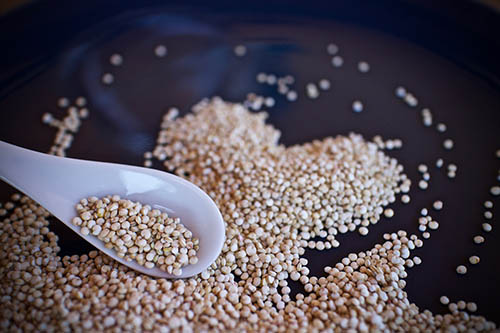Protein is typically associated with animal products, but there are numerous protein-dense options for those who follow plant-based diets.
Protein is a macronutrient that is important for human health, as it is essential for the creation and maintenance of cells in the body. While often associated with the building of muscle tissue, which it indeed supports, protein also is critical for healthy bones, cartilage and skin. The USDA recommends that adults eat between five and seven ounces of protein daily, or a certain number of grams, based on body weight and activity level, to amount to between 10 and 35 percent of one’s total daily caloric intake. “Your minimum protein recommendation can be found by multiplying your weight [in pounds] by 0.36,” says ICE Chef Ann Ziata. “However, that number can be higher for folks who are athletic or more physically active.”
While animal protein is one of the easiest ways to ensure you’re getting enough protein, there are a number of plant-based protein sources for vegetarians to consider. Eating enough protein is especially important for those who are considering, or have just started a plant-based diet. “Someone following a plant-based diet must be mindful in creating nutritionally balanced meals,” says Chef Ann. “For someone new to eating vegetarian or vegan, there may be a little learning curve as they figure out ‘What do I eat now?,’ but after some time, eating balanced plant-based meals becomes second nature.” With Chef Ann’s help, here we look into how to get protein as a vegetarian and incorporate sufficient protein into a plant-based eating pattern.
What's the Difference Between Animal and Plant-Based Protein?
The primary source of animal protein is from both red and white meat, and also poultry and seafood. Meat isn’t the only source of animal protein, however. Animal protein can also come from sources that can be suitable for some vegetarians, including eggs and dairy products, both of which are especially protein-rich foods. Eggs and dairy, however, while acceptable for some vegetarians, do not count as plant-based protein, because they come from animals.
Plant-based protein can come from a large number of sources as well. “Plant-based protein is found in grains, beans, nuts, seeds, vegetables and fruits,” says Chef Ann. “Protein is made from amino acids, and there are nine different amino acids that we need to consume every day.” Animal protein is considered a “complete” source of protein, since it contains all nine amino acids, whereas certain plant-based protein sources need to be combined in order to create complete proteins.
For example, “A serving of black beans contains every essential amino acid, but a low amount of methionine, whereas brown rice contains methionine but doesn’t have threonine nor much lysine,” says Chef Ann. “Combining proteins like eating rice and beans together ensures that someone following a plant-based or vegan diet can get everything they need.” Also of note, these various plant-based protein sources that make up complete proteins, such as rice and beans, don’t need to necessarily be consumed at the same meal, so long as all of the amino acids that comprise complete protein are consumed throughout the same day.

What Are The Best Plant-Based Proteins?
“The highest plant-based sources of protein are tofu and tempeh, which are made from soy, and seitan, which is made from wheat,” says Chef Ann. Tofu and tempeh in particular are considered complete protein sources on their own without needing to combine with other foods. For about 100 grams or about 3.5 ounces, tofu contains about nine grams of protein, and tempeh and seitan both contain around 19 grams.
Other sources of plant-based protein are beans, lentils and legumes, as well as seeds and nuts, which are especially protein-dense. All plant matter contains a certain amount of protein, fruits and vegetables included, and even grains, which are typically thought of as carbohydrates, a different macronutrient than protein. “Some grains contain more protein than others,” says Chef Ann. “Generally, the smaller the grain, like millet and quinoa, the higher the protein.”
Chef Ann recommends a number of different plant-based protein dishes that are satisfying both in terms of nutrition and to the palate. “A plant-based protein on a plate could be falafel, teriyaki tofu, braised tempeh, white beans simmered with herbs, seitan ‘burgers,’ hummus, fava bean croquettes or lentil and millet patties,” she says. “In a pinch, natural, unsweetened peanut butter is one of my favorite protein sources that can be added to stir-fry sauces or just spread over whole-grain crackers.”
Is Whey Protein a Plant-Based Protein?
Those specifically trying to build muscle often rely on protein powder, which is frequently made from whey, to incorporate additional protein into their diet. Whey protein is not plant-based protein, however. “Whey protein is from milk, so it is not considered a plant-based protein,” says Chef Ann. “Whey is vegetarian, but not vegan.” Whey is a byproduct of the cheesemaking process, which separates the curds, the solid material in milk, from the whey, the liquid material. Whey is an excellent source of protein but is considered animal protein, not plant-based protein.
Are Fake Meat Products Good Sources of Protein?
The last few years have seen a number of products that mimic animal protein enter the market, for those looking to adopt more plant-based eating. Everything from plant-based burgers that “bleed,” to plant-alternative chicken nuggets has been growing in popularity. “Fake meat products may be high in protein, but these are very processed forms of protein,” says Chef Ann. “I would recommend relying on more whole protein sources for the majority of your intake.”






